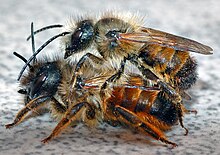Osmia bicornis
| Red mason bee | |
|---|---|
 |
|
| Scientific classification | |
| Kingdom: | Animalia |
| Clade: | Euarthropoda |
| Class: | Insecta |
| Order: | Hymenoptera |
| Family: | Megachilidae |
| Genus: | Osmia |
| Species: | O. bicornis |
| Binomial name | |
|
Osmia bicornis (Linnaeus, 1758) |
|
| Synonyms | |
|
|
Osmia bicornis, synonym Osmia rufa, is a species of mason bee, and is known as the red mason bee due to its covering of dense gingery hair. It is a solitary bee that nests in holes or stems and is polylectic, meaning it forages pollen from various different flowering plants. These bees can be seen aggregating together and nests in preexisting hollows, choosing not to excavate their own. These bees are not aggressive; they will only sting if handled very roughly and are safe to be closely observed by children. Females only mate once, usually with closely related males. Further, females can determine the sex ratio of their offspring based on their body size, where larger females will invest more in diploid females eggs than small bees. These bees also have trichromatic color vision and are important pollinators in agriculture.
This species is part of the order Hymenoptera, which consists of bees, wasps, ants, and sawflies. O. bicornis is the current scientific name for this bee, although it was formerly known as O. rufa. In 1758, Linnaeus described the male of this species under the name Apis rufa and described the female as a separate species Apis bicornis. In 1802 Kirby recognised that A. bicornis and A. rufa were the same species and he named this species Apis bicornis. Subsequently, the opinion was accepted that A. rufa was the correct specific name, because it appeared directly before bicornis in the systema naturae. The use of the name rufa does not comply with the International Code of Zoological Nomenclature's rules which mean that this form of "line priority" does not apply and that the decision of the first revising author, Kirby, must be followed. Thus the correct scientific name for the species is Osmia bicornis, although O.rufa is still widely used. This bee is a member of the family Megachilidae, which mostly consists of solitary bees, and is among 11 species of Osmia identified in Britain. The three subspecies of O. bicornis include O. b. bicornis,O. b. cornigera, and O. b. fractinoris.
O. bicornis is about the same body size as the honeybee. Sexual dimorphism is observed in this species; females are larger than males, because the female larvae are provisioned with (and eat) more pollen. Body size in O. bicornis decreases as temperature in brood cells increases. Beyond 25 °C, body growth can be severely truncated, leading to small adult body size or mortality. The male and females are also distinguishable by antenna length, with males possessing an additional antenna segment, (characteristic of almost all Hymenoptera).
...
Wikipedia
